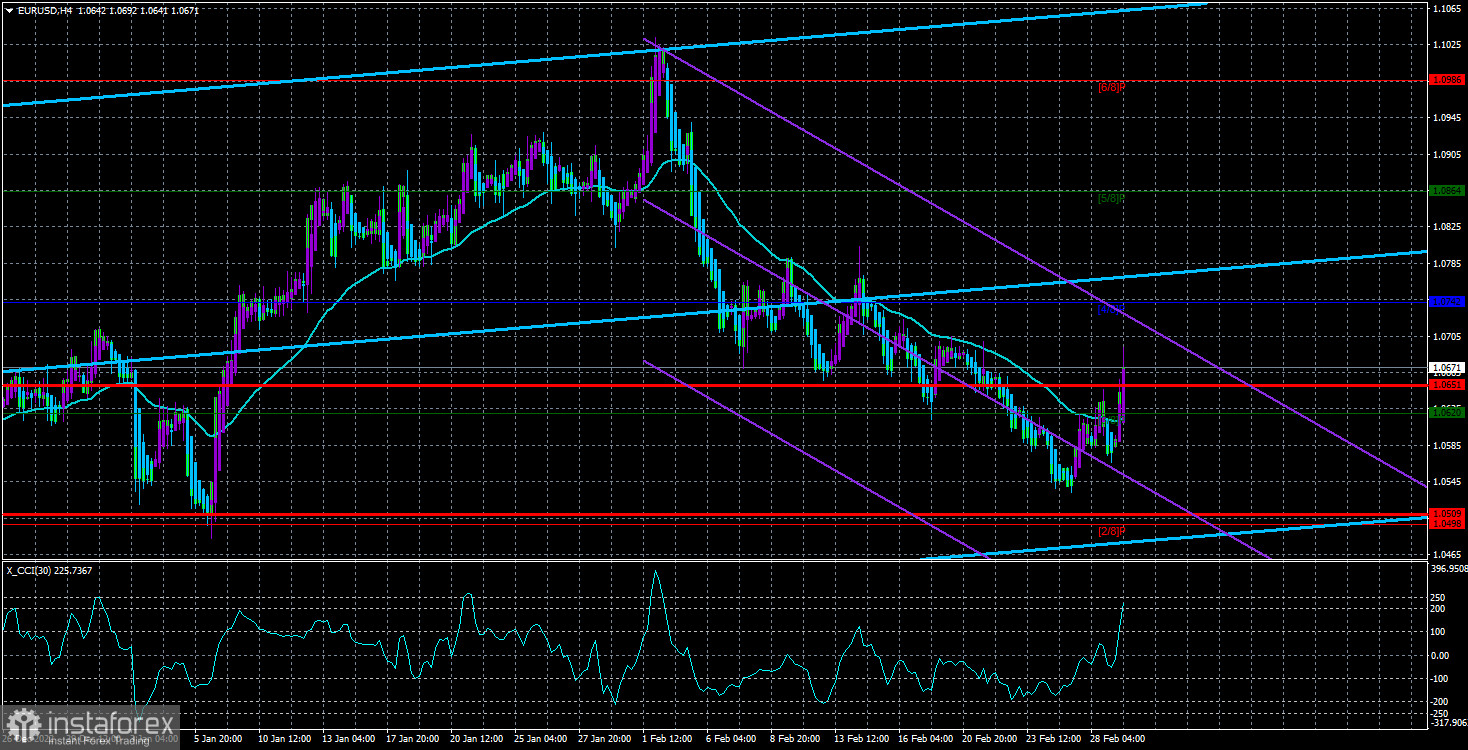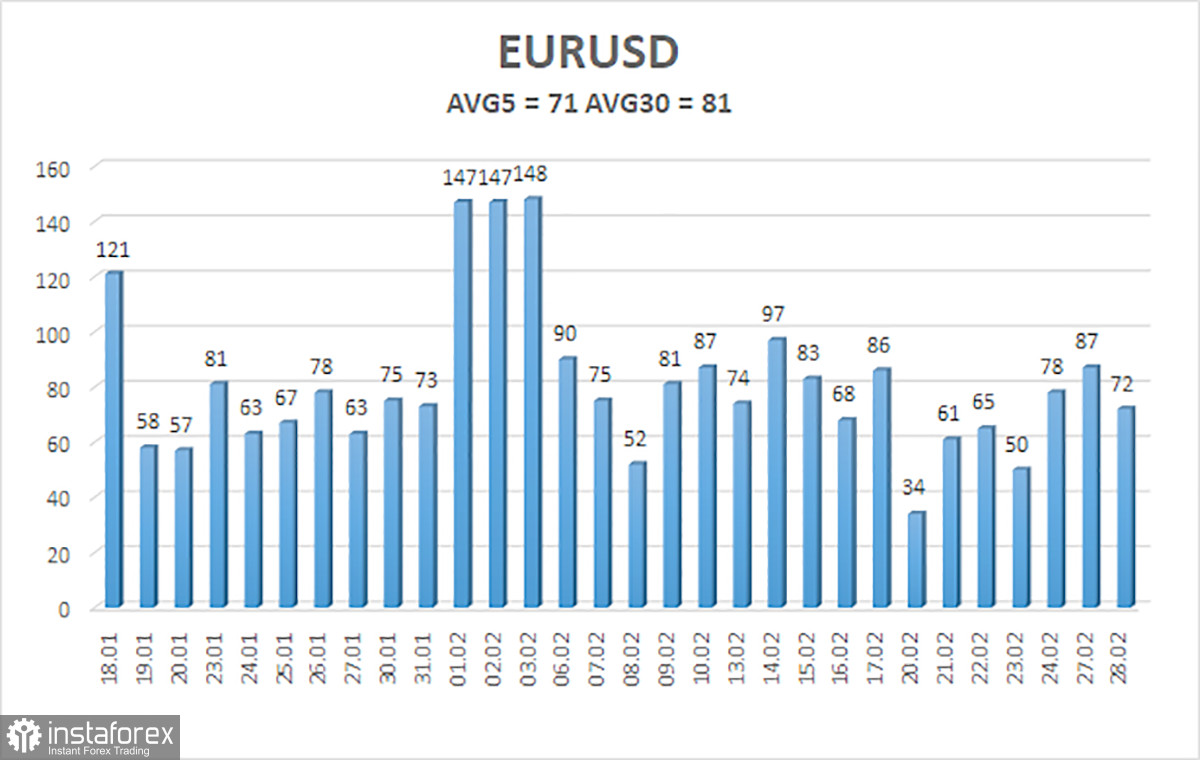
On Tuesday and Wednesday, the EUR/USD currency pair's trading was fairly unstable. What was confusing about it? First of all, the pair frequently changed their direction of movement. This can be seen on practically any TF. Second, the fundamental and macroeconomic backgrounds (which are evident) were almost completely lacking, raising the question of why the pair moved so actively and frequently changed directions if there was nothing for traders to react to. This question has an immediate response: the movements were restless and impulsive. This in turn suggests that the market is currently unsure of what to do with the euro/dollar pair. We have already stated in earlier articles that the basic background is starting to become unclear. The market does not always have a clear opinion on what to do since there is a lack of clear and reliable news and data. Naturally, rates and inflation are the sources of the biggest contradictions. What else might the market be considering at this time? Since many experts and analysts predicted that a recession in the United States and the European Union was unavoidable six months ago, attention was also focused on the state of a particular economy at the time. However, today, everyone agrees that, even if there is a recession, it will be very mild and nearly imperceptible. Nonetheless, the European Union has managed to get through the current winter reasonably unharmed, the recession has not yet materialized, and there was enough gas for everyone, so the economy is still in a respectable state. Although its growth rates are disappointing, at least they exist.
The ECB's rate decisions are therefore currently the largest threat to the European economy. And inflation is their only source of income. Since the ECB lacks a formal justification to stop, the present rate is not even "restrictive" yet. Only a few months of slowing inflation were visible, and in January and February, several EU nations already saw an acceleration of the index. Hence, there is every reason to anticipate that the rate of inflation across all of Europe will start to rise once more. And the regulator is left with no choice but to raise rates going forward.
Does the euro have support for a new upward trend?
Yet, we are also interested in the impact that inflation and rates will have on the chart of the currency pair. Rates will rise in the future, but it is crucial to consider what will happen to rates in the US concurrently. Everything indicates, so far, that the rate will continue to rise in the United States, but by how much more? The market now bases its predictions on the idea that an additional 0.75% rate increase in the European Union is assured and then makes adjustments based on the circumstances. Everyone in the US anticipates a guaranteed increase of 0.5%, and then - depending on the circumstance. It turns out that the conditions for the dollar and the euro are currently rather similar. This knowledge allows us to predict that neither the dollar nor the euro will be more advantageous in the near future.
The euro has been steadily declining in recent weeks; it is currently slightly recovering, but it could start falling again in a week or two. In other words, the growth we are currently experiencing might just be a technical correction and not the start of a new bullish trend. There are no solid foundations for substantial growth for the euro. Even lower than the Fed rate is the ECB rate. Objectively speaking, the American economy outperforms the EU economy. The Fed's rate will continue to rise. Compared to the ECB, the Fed has far more room to tighten monetary policy. All of this means that if the ECB rate increases over the Fed rate over the next three months, it will only do so by a maximum of 0.25%. And returning to the fact that the market had the opportunity to reverse the ECB rate increase by 0.75% in the following two meetings, we again conclude that there are no legitimate reasons for the euro to see significant growth. On Monday, Tuesday, or Wednesday, there was no fundamental foundation in favor of the euro. According to one study, although German inflation is reported, it is not significant because Germany is only one of the EU's 27 member states.

As of March 1, the euro/dollar currency pair's average volatility over the previous five trading days was 71 points, which is considered "normal". Hence, on Wednesday, we anticipate the pair to move between 1.0509 and 1.0651. The Heiken Ashi indicator's downward turn will signal a potential continuation of the downward movement.
Nearest levels of support
S1 – 1.0620
S2 – 1.0498
S3 – 1.0376
Nearest levels of resistance levels
R1 – 1.0742
R2 – 1.0864
R3 – 1.0986
Trade Suggestions:
The EUR/USD pair is attempting to begin an upward trend, which could be a small correction in technical terms. You can continue to hold long positions at this time with a target price of 1.0742 until the Heiken Ashi signal turns down. After the price is fixed back below the moving average line, short positions can be initiated with targets of 1.0509 and 1.0498.
Explanation of the illustrations:
Channels for linear regression - allow us to identify the present trend. The trend is now strong if they are both moving in the same direction.
The short-term trend and current trading direction are determined by the moving average line (settings 20.0, smoothed).
Murray Levels serve as movement and correction targets.
Based on current volatility indicators, volatility levels (red lines) represent the expected price channel in which the pair will trade the following day.
A trend reversal in the opposite direction is imminent when the CCI indicator crosses into the overbought (above +250) or oversold (below -250) zones.
 English
English 
 Русский
Русский Bahasa Indonesia
Bahasa Indonesia Bahasa Malay
Bahasa Malay ไทย
ไทย Español
Español Deutsch
Deutsch Български
Български Français
Français Tiếng Việt
Tiếng Việt 中文
中文 বাংলা
বাংলা हिन्दी
हिन्दी Čeština
Čeština Українська
Українська Română
Română

